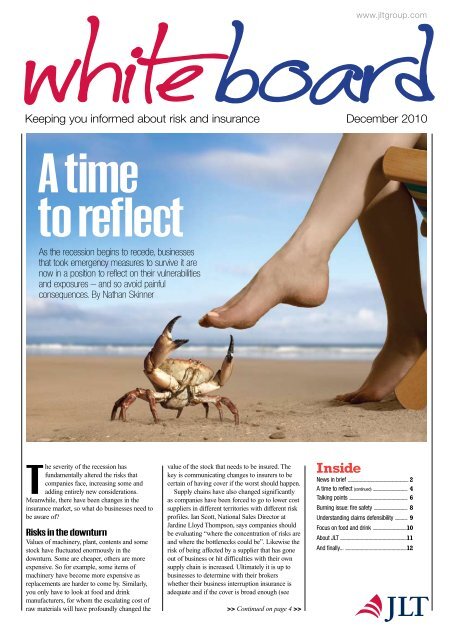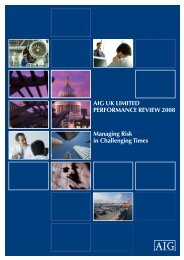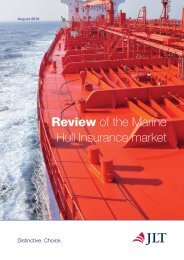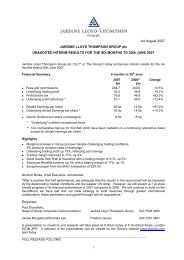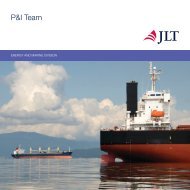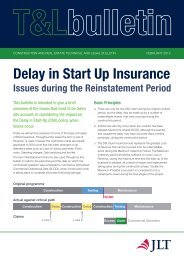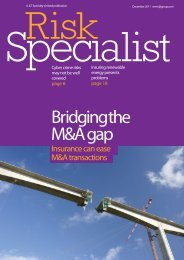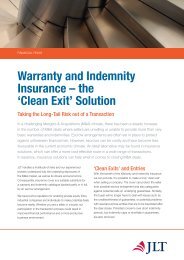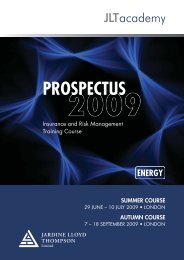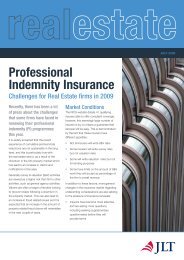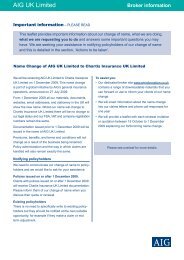Whiteboard Magazine - December 2010 - JLT
Whiteboard Magazine - December 2010 - JLT
Whiteboard Magazine - December 2010 - JLT
You also want an ePaper? Increase the reach of your titles
YUMPU automatically turns print PDFs into web optimized ePapers that Google loves.
whiteboard<br />
www.jltgroup.com<br />
Keeping you informed about risk and insurance <strong>December</strong> <strong>2010</strong><br />
A time<br />
to reflect<br />
As the recession begins to recede, businesses<br />
that took emergency measures to survive it are<br />
now in a position to reflect on their vulnerabilities<br />
and exposures – and so avoid painful<br />
consequences. By Nathan Skinner<br />
The severity of the recession has<br />
fundamentally altered the risks that<br />
companies face, increasing some and<br />
adding entirely new considerations.<br />
Meanwhile, there have been changes in the<br />
insurance market, so what do businesses need to<br />
be aware of<br />
Risks in the downturn<br />
Values of machinery, plant, contents and some<br />
stock have fluctuated enormously in the<br />
downturn. Some are cheaper, others are more<br />
expensive. So for example, some items of<br />
machinery have become more expensive as<br />
replacements are harder to come by. Similarly,<br />
you only have to look at food and drink<br />
manufacturers, for whom the escalating cost of<br />
raw materials will have profoundly changed the<br />
value of the stock that needs to be insured. The<br />
key is communicating changes to insurers to be<br />
certain of having cover if the worst should happen.<br />
Supply chains have also changed significantly<br />
as companies have been forced to go to lower cost<br />
suppliers in different territories with different risk<br />
profiles. Ian Scott, National Sales Director at<br />
Jardine Lloyd Thompson, says companies should<br />
be evaluating “where the concentration of risks are<br />
and where the bottlenecks could be”. Likewise the<br />
risk of being affected by a supplier that has gone<br />
out of business or hit difficulties with their own<br />
supply chain is increased. Ultimately it is up to<br />
businesses to determine with their brokers<br />
whether their business interruption insurance is<br />
adequate and if the cover is broad enough (see<br />
>> Continued on page 4 >><br />
Inside<br />
News in brief ............................................................................. 2<br />
A time to reflect (continued) ........................................... 4<br />
Talking points ....................................................................... 6<br />
Burning issue: fire safety ......................................... 8<br />
Understanding claims defensibility ................ 9<br />
Focus on food and drink ..........................................10<br />
About <strong>JLT</strong> .................................................................................11<br />
And finally... ...........................................................................12
newsinbrief<br />
Rounding up the latest news and developments from the world of insurance<br />
Political violence<br />
or terrorism insurance<br />
Tough economic times and global<br />
austerity is fuelling a rise in political<br />
violence; from riots in Greece to<br />
political violence in Thailand. In this<br />
environment, companies with<br />
overseas assets should consider<br />
political violence cover.<br />
Terrorism cover is more<br />
commonly purchased, and readily<br />
available, but Kelly Crouch, Head of<br />
Terrorism at Jardine Lloyd<br />
Thompson, recommends firms buy<br />
political violence cover too.<br />
She explains: “It’s all down to<br />
definition. The political violence in<br />
Thailand this year was named as<br />
terrorism by the government, but a<br />
UK court might argue it was not<br />
terrorism as we understand it.<br />
Without a clear definition, those who<br />
only took terrorism insurance may<br />
find the cover is not responding.”<br />
Political violence cover extends to<br />
these sorts of problems. “For an<br />
extra 5 or 10 per cent they could<br />
have bought a more comprehensive<br />
cover,” Crouch says.<br />
She emphasises it is worth being<br />
proactive. “Don’t wait until political<br />
violence erupts in one of your<br />
trading countries as the price will<br />
explode and capacity will implode. If<br />
you have been a customer for years<br />
underwriters will have a capacity set<br />
aside for you,” she says.<br />
Political unrest in Thailand: but was it terrorism<br />
World Risk Review<br />
To help companies understand the political risks<br />
they face, Jardine Lloyd Thompson has developed<br />
the World Risk Review. This provides short- to<br />
medium-term assessments of the level of risk<br />
associated with a range of political and economic<br />
perils. Nine perils are rated in 197 countries,<br />
drawing from 53 international sources, to deliver<br />
an understanding of the relative level of risk<br />
associated with each peril.<br />
> www.worldriskreview.com<br />
Insurance for<br />
construction vehicles<br />
An area of common concern for construction<br />
companies is which policy should insure damage<br />
or liability arising from the use of construction<br />
vehicles: construction all risks or a motor policy.<br />
A variety of factors will determine which insurance<br />
policy provides indemnity.<br />
There are questions of the use the vehicle is<br />
being put to, the type of vehicle, the type of risks<br />
that need to be covered, and the precise meaning<br />
of wording within the policy such as ‘tools of trade’.<br />
Great care also needs to be taken that the cover<br />
provided by the various insurance policies both<br />
dovetail and match the requirements.<br />
For more information about this topic please<br />
contact jltlimited@jltgroup.com.<br />
63.8%<br />
is the total tax and National Insurance payable<br />
on a bonus to an employee on the new top rate<br />
of tax this year (<strong>2010</strong>/2011)<br />
65.8%<br />
is the total tax and National Insurance payable<br />
on a bonus to an employee on the new top rate<br />
of tax next year (2011/2012)<br />
0%<br />
is the total tax and National Insurance payable<br />
on a bonus that is diverted into an employee’s<br />
pension scheme if it’s within the new limits.<br />
Graham Cooke of <strong>JLT</strong> Wealth Management<br />
outlines how you could reduce your tax liabilities<br />
on the back page.<br />
Employers’ liability trigger litigation decision creates uncertainty<br />
After a year of deliberation, the Court of<br />
Appeal handed down a decision in the<br />
ongoing employers’ liability (EL) trigger<br />
litigation, making the situation regarding<br />
insurance coverage for long-tail disease claims<br />
uncertain for insurers and some policyholders.<br />
Essentially, the ruling will leave clients with pre-<br />
1972 EL insurance written on an ‘injury sustained’<br />
basis with no cover for mesothelioma claims caused<br />
by exposure to asbestos before 1972.<br />
Equally, claimants who were employed by now<br />
insolvent businesses may have no recourse at all.<br />
Policyholders would be prudent to research their<br />
EL insurance history now so that any potential<br />
gaps in cover thrown up by this latest ruling can<br />
be identified.<br />
Graham Terrell, Technical Adviser with Jardine<br />
Lloyd Thompson’s Global Risk Solutions division,<br />
says: “With the conventional insurance market’s lack<br />
of appetite for asbestos-related risks policyholders<br />
will really have two choices: to wait and see if<br />
claims that are not covered by an insurance policy<br />
are lodged, at which point they reflect it in the profit<br />
and loss, or make some provision for such losses<br />
in an existing captive or by using a cell in a renta-captive.”<br />
• Jardine Lloyd Thompson has issued a bulletin<br />
covering this issue. For your copy visit<br />
www.jltgroup.com/risk-and-insurance/publications.<br />
2 <strong>Whiteboard</strong> / <strong>December</strong> <strong>2010</strong>
What the Employers’ Liability Insurance<br />
Database means for you<br />
The Employers’ Liability (EL) Insurance<br />
Database, operated by the Employers’ Liability<br />
Tracing Office, looks set to become a reality.<br />
The proposals are designed to help employees<br />
trace old insurance records to track down the<br />
relevant employer’s policy if they suffer from<br />
injury or disease caused at work. Previously if the<br />
employer had ceased trading, was untraceable, or<br />
could not identify the relevant policy, employees<br />
had little recourse. Some 3,210 could not trace<br />
their employer or insurer in 2008.<br />
The Financial Services Authority (FSA)<br />
finished consulting on proposals in September.<br />
Among the positive feedback was that from the<br />
British Insurance Brokers’ Association (BIBA).<br />
Peter Staddon, British Head of Technical Services<br />
for BIBA, said it would: “create a system that<br />
makes it much easier and more successful when<br />
tracing employers’ liability insurance records,<br />
which is vitally important at a time when people<br />
are suffering from a disease”.<br />
Graham Terrell, a Technical Adviser at Jardine<br />
Lloyd Thompson, points out that the move would<br />
also benefit employers: “This addresses those<br />
instances where employers have been left without<br />
employers’ liability cover where they cannot trace<br />
the insurer.”<br />
Terrell adds however that there is one caveat:<br />
“In the short term there is going to be a lot of<br />
extra work. Part of the entry onto the system will<br />
be a data template which has to be filled in with<br />
all the details of the business and the employer<br />
reference number (ERN). If the business has a<br />
number of subsidiary companies, a separate<br />
record has to be completed for each subsidiary –<br />
whether there is a handful or a hundred of them.<br />
Insurance buyers need to be aware that they will<br />
have to provide the ERN in each instance.”<br />
The FSA is expected to report its findings<br />
before the end of the year. If it goes ahead it will<br />
amend the Insurance: Conduct of Business<br />
Sourcebook (ICOBS) to embody the new rules.<br />
The register will include all policies under which<br />
UK commercial lines EL cover has been<br />
provided to employers which commenced or<br />
were renewed or for which claims were made on<br />
or after 1 November 1999.<br />
The problem is the initial naivety of government<br />
and some large businesses in thinking that chief<br />
executives or shop floor management have the skills or<br />
inclination to carry out a fire risk assessment.<br />
Ian Gough, Fire Safety Consultant, discusses the flaws in the system on page 8<br />
UK insurance premium tax rate increase<br />
Jardine Lloyd Thompson called on HM Treasury to<br />
introduce transitional arrangements for the insurance<br />
premium tax (IPT) increase, to reduce uncertainty and<br />
administrative complications. This was part of a joint<br />
industry submission by the Association of British<br />
Insurers and the International Underwriting<br />
Association.<br />
The Emergency Budget announced that IPT would<br />
rise from 5% to 6%, but did not include transitional<br />
provisions. HM Treasury had previously responded to<br />
a separate representation from the London &<br />
International Insurance Brokers’ Association (LIIBA)<br />
requesting transitional arrangements. It said there<br />
would be no concessionary period but admitted this<br />
“may cause difficulties in processing and accounting<br />
for tax on certain policies that incept before the date<br />
of the rate rise.”<br />
The tax rules mean that the new rate will apply to<br />
some policies that incepted before 4 January 2011,<br />
depending on the tax accounting procedures adopted<br />
by insurers. In some cases, the new rate may apply to<br />
additional premiums in respect of policies covering<br />
risk in <strong>2010</strong>. Brokers will need to ask individual<br />
insurers to instruct which rates of IPT apply to<br />
policies that incept before 4 January 2011. This could<br />
result in both the old and new rates being applied to<br />
different parts of a policy underwritten by several<br />
insurers, depending on the tax accounting procedures<br />
of the insurers.<br />
LIIBA has opened discussions with insurance<br />
sector associations to agree a protocol for<br />
implementing the IPT rate rise.<br />
Blogroll<br />
The latest blogs from Jardine Lloyd Thompson’s<br />
website www.jltgroup.com<br />
Construction<br />
Mike Johnson asks: why doesn’t a drop in<br />
accident rates result in lower Employer’s Liability<br />
(EL) rates Full and proper information gathering<br />
at the time of an accident can mitigate claims<br />
costs substantially.<br />
> www.jltgroup.com/jlt-limited/blogs/construction<br />
Real Estate<br />
Bill Gloyn urges firms: don’t ignore insurance in<br />
the case of fit-out contracts. When dealing with a<br />
property insured by a third party, an approach<br />
has to be made to that party at an early stage.<br />
> www.jltgroup.com/jlt-limited/blogs/connect-to-real-estate<br />
Global Risk Solutions<br />
Luke Foord-Kelcey looks at cyber extortion – a<br />
growing racket that is increasingly attractive to<br />
cranks and organized criminals alike.<br />
> www.jltgroup.com/jlt-limited/blogs/global-risk-solutions<br />
Global Risk Solutions<br />
Sarah Best looks at personal liability in<br />
Germany, arguing that it’s good to be aware of<br />
bespoke cover extensions under local insurance<br />
policies which may fly under the radar.<br />
> www.jltgroup.com/jlt-limited/blogs/global-risk-solutions<br />
whiteboard<br />
This newsletter is published for the benefit of clients<br />
and prospective clients of Jardine Lloyd Thompson<br />
Limited. It is intended only to highlight general<br />
issues relating to the subject matter which may be<br />
of interest and does not necessarily deal with every<br />
important topic nor cover every aspect of the topics<br />
with which it deals. If you intend to take any action<br />
or make any decision on the basis of the content of<br />
this newsletter, you should first seek specific<br />
professional advice and verify its content.<br />
Jardine Lloyd Thompson Limited<br />
Tel: +44 (0)20 7528 4000 /<br />
Fax: +44 (0)20 7528 4500<br />
Web: www.jltgroup.com<br />
Lloyd’s Broker. Authorised and Regulated by the<br />
Financial Services Authority. A member of the<br />
Jardine Lloyd Thompson Group. Registered Office:<br />
6 Crutched Friars, London EC3N 2PH.<br />
Registered in England No. 01536540.<br />
VAT No. 244 2321 96. © <strong>December</strong> <strong>2010</strong><br />
Publishing services<br />
Provided by Grist: www.gristonline.com<br />
www.jltgroup.com 3
A time<br />
to reflect<br />
Cover story continued<br />
>> page 6 for a Masterclass in Business<br />
Interruption).<br />
“Business is changing at a fast rate<br />
because of the recession,” adds Jardine<br />
Lloyd Thompson Client Service Director,<br />
Alan Percival. A company, for example,<br />
that has been forced to pursue customers<br />
by expanding into new markets, such as the<br />
US, faces a different operating environment<br />
and risk profile. “It is important to review<br />
those changes,” he says.<br />
Belt-tightening pitfalls<br />
Recessionary belt-tightening has also<br />
increased some risks. In an effort to<br />
survive the recession, some companies<br />
trimmed expenditure in non-core areas,<br />
such as health and safety, loss prevention<br />
or staff training – something that insurers<br />
call risk engineering. “Some companies<br />
may have, for example, cut back on<br />
maintenance to keep their overheads<br />
down,” says Scott. But this could leave<br />
businesses exposed.<br />
When the pressure to cut costs is high<br />
some businesses may consider pulling back<br />
and insuring less to save some premiums.<br />
But it could be a “false economy” if it<br />
comes to a claim, says Percival. Instead, he<br />
insists, there may be areas where costs can<br />
be reduced without sacrificing the level of<br />
protection. “If a client has mothballed a<br />
plant, for example, they need to consider if<br />
the basis of cover should change from, say<br />
full reinstatement to indemnity, to<br />
accurately reflect the changed exposure.”<br />
Workforce risks<br />
If a business has been forced to downsize<br />
or cut the workforce, they face more risks.<br />
Companies now have an opportunity<br />
to update their risk profile and achieve the<br />
best deal in terms of cost and cover.<br />
Ian Scott, National Sales Director, Jardine Lloyd Thompson<br />
One is the threat of lawsuits. “In these<br />
circumstances there’s often an increase in<br />
claims,” says Scott. Percival suggests that<br />
companies forced into making lots of<br />
redundancies might “want to look at<br />
employment practices liability or some<br />
other form of legal expenses cover”. Jon<br />
Fitzsimons, a Claims Consultant from<br />
Echelon Claims Consultants, also suggests<br />
employers consider a claims defensibility<br />
audit: “This will highlight any potential<br />
vulnerabilities which may enable an<br />
employee to make a claim or damage the<br />
employer’s ability to defend one.”<br />
Another risk associated with downsizing<br />
is that companies may lose experienced<br />
workers in their business, which could<br />
affect the quality of their products or<br />
services. As a result “are you getting the<br />
right professional indemnity, public<br />
liability or product liability insurance”<br />
asks Scott.<br />
Renegotiate and review<br />
Insurers look for a core base of clients<br />
who practice good risk management.<br />
Terry Whittaker, Managing Director,<br />
Distribution, QBE European<br />
Operations, explains: “There’s<br />
opportunity within the market<br />
Steps taken during the recession<br />
The economic downturn has drastically raised the pace of change in the business<br />
world. Such a severe recession has altered existing risks companies face and added<br />
new ones. These include:<br />
A sharp surge in outsourcing and overseas<br />
joint venture activity which is significantly<br />
increasing supply chain complexity.<br />
Companies moving into unfamiliar product<br />
areas and territories.<br />
Speeding up product launches (creating<br />
unknown quality or liability issues, internally<br />
and with suppliers).<br />
Supply chain vulnerability has increased.<br />
More than 80 per cent of businesses say<br />
this issue had changed their risk profile (for<br />
example by cutting the number of<br />
suppliers and distribution centres or by<br />
relying on lowest cost suppliers regardless<br />
of their reliability or capability to sustain<br />
claims).<br />
Increased outsourcing to unknown or highrisk<br />
locations (pushing down unit cost at<br />
the probable expense of quality and<br />
reliability).<br />
Firms have faced pressure to accept extra<br />
liabilities in areas like product warranties,<br />
recall costs, design risk, consequential loss<br />
and so on. More than a quarter of<br />
manufacturers cited such pressures having<br />
already caused them to accept more risk.<br />
Reducing supervision in key areas such as<br />
health and safety or contract oversight.<br />
Source: Mactavish report<br />
4 <strong>Whiteboard</strong> / <strong>December</strong> <strong>2010</strong>
The insurance<br />
market remains to a<br />
large extent a buyers’<br />
market, with plenty<br />
of competition and<br />
spare capacity.<br />
for recognition from insurers of those<br />
clients who commit to long term<br />
improvements, risk management services,<br />
risk funding and health and safety<br />
consultancy and advice being the usual<br />
vehicles for that recognition.”<br />
All this change means businesses should<br />
be reviewing their cover. However, in spite<br />
of the competitive insurance market,<br />
companies do not seem to be doing so,<br />
finds Scott. He says: “Quite rightly<br />
companies have been focusing on the<br />
pressing matter of survival during the<br />
downturn, and some may have taken their<br />
eye off the insurance ball. It means they<br />
now have an opportunity to revisit cover,<br />
cost and contributions to secure the best<br />
overall deals possible.”<br />
Market trends<br />
Generally speaking, even though risk<br />
profiles may have changed, insurers have<br />
not gone around slashing cover. “What<br />
brokers have been able to do to allay fears,<br />
is to stand strong in the market and to win<br />
savings without reducing the extent of the<br />
cover,” says Scott. “A good broker should<br />
make certain the insurance programme is<br />
aligned to the business exposures and<br />
make sure it changes with time. They<br />
should have regular meetings with<br />
the client and insurer to gather that<br />
information.”<br />
The insurance market remains<br />
to a large extent a buyers’<br />
market. Competition and plenty<br />
of spare capacity means that<br />
commercial insurance buyers are<br />
in the enviable position of being<br />
able to lock in good deals at a<br />
decent price. “The insurance<br />
market is still soft and receptive<br />
for companies with a better than<br />
average claims profile,” indicates<br />
Scott. How long this soft market<br />
can continue is a point of much<br />
debate, but most commentators<br />
agree it looks set to last through 2011.<br />
Opportunities<br />
All this means that now is the time to get<br />
the breadth of cover required at the right<br />
price. “There is sufficient capital and<br />
competition in most insurance lines,”<br />
says Percival. Right now there is<br />
aggressive competition in<br />
property and casualty lines and<br />
prices are “down or static”.<br />
Buildings, contents<br />
and stock may have<br />
changed, and this must be<br />
communicated to insurers.<br />
Supply chains have changed significantly<br />
so undertake a business interruption<br />
review.<br />
Cutting back risk engineering is a false<br />
economy, as the best deals are reserved<br />
for those with strong processes.<br />
Downsizing businesses may benefit from<br />
legal expenses cover and a claims<br />
defensibility audit.<br />
Companies should check professional<br />
indemnity, public liability and product<br />
liability insurance against new/revised<br />
contracts.<br />
The insurance market remains a buyers’<br />
market. Now is the time to lock in breadth<br />
of cover at the right price.<br />
The situation is paralleled in accident and<br />
marine insurance classes. Rates are<br />
“marginally increasing” in motor, he says,<br />
but if the client has a good claims history<br />
then rates should hold. Financial lines are a<br />
little trickier. Solicitors’ professional<br />
indemnity, for example, is a “hospital case,<br />
with insurers running scared,” says Percival,<br />
whereas professional indemnity for the<br />
com/tech sector is highly competitive.<br />
“Clients may be able to consolidate<br />
insurance costs and lock in good terms with<br />
a long terms rate deal,” says Percival. If<br />
these kinds of agreements can be found, he<br />
says: “They are a lot more advantageous to<br />
the client because the insurer is duty bound<br />
to stick to a set rate. Right now that’s very<br />
attractive.”<br />
To discuss any of the issues<br />
raised in this article contact<br />
Ian Scott on 0113 203 5832 or<br />
Ian_Scott@jltgroup.com<br />
www.jltgroup.com 5
points<br />
Jargon<br />
buster<br />
Insurable gross<br />
profit (IGP)<br />
The net result of deducting<br />
variable costs from turnover (with<br />
adjustments for opening and<br />
closing stocks).<br />
Indemnity period<br />
The period for which the policy<br />
operates and relates to the time it<br />
takes to reinstate damaged<br />
facilities, plant, machinery,<br />
equipment and contents and<br />
recovery of market share. As a<br />
minimum this should be 12<br />
months and is often 18 or 24<br />
months or longer. Since a loss<br />
can occur towards the end of an<br />
insurance year, businesses need<br />
to declare budgeted and forecast<br />
financial data for three years to<br />
insurers.<br />
Interdependency<br />
Where damage within one part of<br />
your own business has a knockon<br />
effect on another part of your<br />
business.<br />
Increased Costs<br />
of Working (ICOW)<br />
Insurers are always open to pay<br />
for ICOW that ultimately reduces<br />
a gross profit claim.<br />
Additional Increased<br />
Costs of Working (AICOW)<br />
ICOW will allow businesses to<br />
spend £1 for every £1 saved in<br />
IGP. However, in order to keep<br />
customers, some businesses will<br />
need to operate at a loss for a<br />
period. AICOW allows you to<br />
spend more than you would save<br />
in gross profit.<br />
Master class<br />
Tim Cracknell, Partner, Jardine Lloyd Thompson<br />
Business interruption<br />
cover: Getting it right<br />
Q Do I need business<br />
interruption insurance<br />
All types of businesses can suffer interruption from<br />
natural or man-made disaster and may incur extra<br />
costs or have reduced revenue. Therefore, arguably all<br />
businesses should buy business interruption (BI)<br />
coverage and have business continuity plans (BCPs) in<br />
place to mitigate the risk.<br />
If an interrupting event arises, the BI policy will first<br />
be used to meet the increased costs of working<br />
(ICOW), such as outsourcing or renting alternative<br />
facilities. These costs are incurred on the basis that it<br />
will minimise a claim for lost insurable gross profit<br />
(IGP). The policy tends to respond later to any IGP loss<br />
claim.<br />
Businesses may buy cover on an ‘all risks’ or ‘fire<br />
and perils’ basis. The ‘perils’ aspect covers a number<br />
of specific perils with an exact definition in law so<br />
coverage is restrictive. All risks will cover most events<br />
– aside from stated exclusions.<br />
Q How do I work out how<br />
much cover I need<br />
Typically mid-market businesses will insure their<br />
annual insurable gross profit (IGP) for a specified<br />
period: called the ‘indemnity period’. You need to make<br />
sure it covers the time it takes to get the business<br />
back on track (see jargon buster). If the IGP was £10<br />
million, for example, and it would take the business 18<br />
months to get back to the position it would have been<br />
in without the loss, the sum insured is £15 million.<br />
Extensions to the BI policy should also be<br />
considered. Examples are interdependency, additional<br />
increased costs of working (AICOW), suppliers,<br />
customers, fines and penalties, denial of access,<br />
infectious diseases and utilities (see jargon buster).<br />
II<br />
Q What pitfalls are going<br />
to catch me out<br />
Pitfalls include: declaring an incorrect sum insured,<br />
buying too short an indemnity period, not buying the<br />
right extensions, not tailoring policy wording to the<br />
needs of a business and failing to tailor extensions to<br />
the exposure.<br />
Many businesses declare a sum insured that<br />
excludes some fixed costs or includes variable costs.<br />
The result can be understating or overstating the sum<br />
insured, which may result in a claim being reduced or<br />
too much premium being paid.<br />
In terms of an incorrect indemnity period, even after<br />
your facility is reinstated your customers will take time<br />
to come back. Buying too short an indemnity period,<br />
can leave the business with a gap in their finances.<br />
Q What are the implications<br />
of getting it wrong<br />
At worst, insolvency. In most cases businesses will<br />
incur unbudgeted costs, miss financial targets and<br />
have to issue profit warnings.<br />
Q So how do I go about<br />
getting it right<br />
Take professional advice. Jardine Lloyd Thompson<br />
offers a BI healthcheck service. This includes making<br />
sure the policy wording is tailored to the risk, and<br />
developing BI underwriting presentations that reflect<br />
the risk to the insurance market in a compact manner<br />
and in a way that gets you the best result. It also<br />
provides a BCP service.<br />
5 tips<br />
PAUSE<br />
...on auditing a BI programme<br />
1 Know the BI risk, evaluate the exposure<br />
2 Don’t forget interdependencies or things that happen outside of damage to your property<br />
3 Contrast the exposure with current coverage<br />
4 Identify areas of inadequacy or over-purchasing – tailor coverage to your needs<br />
5 Obtain premium pricing for changes to cover<br />
6 <strong>Whiteboard</strong> / <strong>December</strong> <strong>2010</strong>
Did you know...<br />
Causes of data breaches<br />
Cyber risks are on the rise<br />
Every organisation is exposed to some<br />
kind of cyber liability. Cyber attacks are<br />
growing in frequency and sophistication,<br />
and every business has its vulnerable<br />
points. Even those that do not trade<br />
online still rely to some degree on<br />
technology to support business<br />
performance. That may be through<br />
purchasing supplies online, using<br />
websites for promotion and service<br />
delivery, for key business processes such<br />
as sales using cloud computing<br />
technology or simply maintaining client<br />
and staff records on IT systems. Many<br />
mid-market companies are not aware that<br />
under general insurance programmes<br />
cover may be limited or non-existent.<br />
A major data loss that affects a<br />
company, whether malicious or<br />
accidental, can seriously damage the<br />
balance sheet. The average organisation<br />
cost of a data breach was £1.68 million in<br />
2009. Regulators are cracking down on<br />
firms that lose customer or employee<br />
information with huge fines (the costs of<br />
defending these actions may be<br />
insurable). And companies that lose their<br />
customers’ personal information will also<br />
suffer a tough reputational hit.<br />
Cyber losses fall into two main<br />
categories, first and third party. Thirdparty<br />
risks are the ones most commonly<br />
associated with cyber risks, they include<br />
contractual penalties due to IT failure and<br />
privacy infringements after data theft.<br />
First-party risks are those losses that<br />
occur directly to the insured, such as loss<br />
of profits from spying, or destruction of<br />
corporate data and resultant business<br />
interruption due to malicious attacks,<br />
sometimes by rogue employees but also<br />
by sophisticated cyber criminals.<br />
Cyber policies will cover both. It is a<br />
growing and competitive market, and<br />
with the escalation in attacks, there has<br />
been a rise in the number of claims, so<br />
that insurers now have the data to enable<br />
them to price policies competitively. A<br />
comprehensive policy will cover firstand<br />
third-party risks for everything from<br />
theft of data to a hacker or virus attack.<br />
In addition to a sound insurance<br />
programme, good risk management and<br />
support from the IT department are<br />
critical in handling cyber risks effectively.<br />
Robust security measures should be<br />
developed in cooperation with the IT<br />
department. An incident response plan<br />
should be used to assist business<br />
continuation in the event of a cyber<br />
attack. This might include ‘hot seats’ so<br />
that crucial business functions can be<br />
carried out off site.<br />
Competent risk management, quality<br />
IT security software and a solid cyber<br />
risks policy are the best methods of<br />
dealing with cyber risks. The insurance<br />
policy acts to support IT security, as it is<br />
not possible to prevent every sort of<br />
cyber attack.<br />
24%<br />
Malicious or<br />
criminal attacks<br />
30% 46%<br />
System glitch Negligence<br />
Average cost per record<br />
of a data breach<br />
£47 £60 £64<br />
2007 2008 2009<br />
Source: 2009 Annual Study: Cost of a Data Breach<br />
dupe 5mm<br />
Back to basics<br />
Environmental liability<br />
It is no longer true that the only companies exposed to<br />
environmental liabilities are the ones in heavy industries. A new<br />
European legal provision called the Environmental Liability<br />
Directive, imposes strict new environmental liabilities. All<br />
companies are now legally accountable for the pollution they<br />
cause and for remediating any damage to the environment.<br />
Traditional public liability insurance won’t respond to these new<br />
liabilities, being limited to third-party claims emanating from<br />
sudden or accidental pollution, so firms are turning to specialist<br />
environmental insurance.<br />
One thing to consider is whether<br />
any of your sites are close to areas of<br />
outstanding natural beauty. That’s<br />
because the new environmental rules<br />
include a provision which means that polluters may have to<br />
remediate a site to the condition it was in before the pollution took<br />
place. This can be particularly expensive in areas that have a<br />
unique ecosystem or particularly delicate biodiversity.<br />
In one recent case a famous celebrity chef was ordered to pay<br />
compensation after his pub polluted a nearby stream with sewage<br />
effluent. The Yew Tree Inn was found to be discharging sewage<br />
into the stream causing it to become toxic. The £38,000 fine<br />
included compensation to two nearby residents.<br />
Jardine Lloyd Thompson recently designed an Environmental<br />
Impairment Liability policy to respond to the environmental risks<br />
faced by businesses today. The cost-effective policy will provide<br />
for the legal costs in respect to regulatory action and civil claims<br />
as well as for clean-up costs to contaminated soil or groundwater.<br />
www.jltgroup.com 7
Burning issue: fire safety<br />
Companies have been responsible for their own fire risk assessments since 2006. The concern is that many<br />
are falling short, and exposing themselves to the risk of fines and prosecution. By Nathan Skinner<br />
The Regulatory Reform (Fire Safety)<br />
Order that came into effect in<br />
October 2006 is a major game<br />
changer. Responsibility for<br />
conducting a fire risk assessment no longer<br />
rests with the fire service but is the duty of<br />
any contractor, business, public sector or<br />
voluntary organisation that owns or<br />
operates a building.<br />
Tony Phillips, Risk Consultant at Jardine<br />
Lloyd Thompson, explains: “Basically the<br />
regulation takes away the requirements for<br />
fire certification from the fire brigade and<br />
puts the onus on carrying out a fire<br />
inspection with a ‘responsible person’.”<br />
Unfortunately the changes have led to a<br />
degradation in the quality of fire risk<br />
assessments, says Phillips. Some buildings<br />
have no risk assessment at all or only a<br />
superficial one, he says, and because<br />
inspections are few and far between, many<br />
operators are getting away with it. Ian<br />
Gough, a former senior fire officer for<br />
Birmingham and Northamptonshire, and<br />
now a Fire Safety Consultant, agrees: “The<br />
problem is the initial naivety of government<br />
and some large businesses in thinking that<br />
chief executives or shop floor management<br />
have the skills or inclination to carry out a<br />
fire risk assessment.”<br />
Lack of training<br />
Inspections are routinely carried out by<br />
people who are not properly trained. Whereas<br />
large companies can probably afford to pay a<br />
consultant to do their fire risk assessment,<br />
smaller organisations cannot and often don’t<br />
have the expertise. “When we carry out<br />
audits we are finding some very poor quality<br />
fire risk assessments,” continues Phillips.<br />
“The competency of the people who have<br />
carried them out is questionable and the staff<br />
are not trained. Basically it’s not worth the<br />
paper it’s written on.”<br />
The most important<br />
action for companies to<br />
take to meet their legal obligations are:<br />
Ensure the responsible person is<br />
competent and the fire risk<br />
assessment is up to speed.<br />
Ensure the risk assessment is<br />
building-specific.<br />
Ensure identified actions are planned<br />
and their implementation is properly<br />
managed.<br />
£ 25k<br />
£ 20 k<br />
£ 15k<br />
£ 10k<br />
£ 5k<br />
2001 2002 2003 2004 2005 2006 2007 2008<br />
Furthermore, the regulations have led to<br />
a growth in the number of fire safety<br />
consultants, many of whom are not fit for<br />
purpose, while the declining numbers of<br />
fire safety officers in the fire service tend<br />
to focus on residential rather than<br />
commercial property, adds Gough.<br />
“The most important thing is that<br />
the person who does the fire risk<br />
assessment should be competent,<br />
but this doesn’t always mean<br />
paying large sums of money to<br />
external advisers.”<br />
There are cowboys trying to<br />
make money out of this. Using the<br />
wrong consultants could cost lives<br />
and destroy businesses. The<br />
difficulty is in finding the right level of<br />
advice or in-house training and<br />
organisations such as the Institution of Fire<br />
Engineers and the Awarding Body for the<br />
Built Environment are working to provide<br />
recognised qualifications for this new<br />
industry,” says Phillips. Proper fire safety<br />
training is available through accredited<br />
courses, such as those run by the Fire<br />
Protection Association.<br />
More prosecutions<br />
Businesses cannot escape the rules forever.<br />
There is a growing list of prosecutions and<br />
large fines against companies that have<br />
failed to carry out a fire risk assessment<br />
properly.<br />
Many of these offences would have been<br />
treated as minor under the old rules, says<br />
Gough. According to the Chief Fire<br />
Officers Association 60 companies or<br />
Average cost of a fire claim<br />
£7bn<br />
The estimated cost of fire<br />
in England and Wales<br />
Commercial<br />
Domestic<br />
individuals in England were found guilty of<br />
the most serious breaches of the law in<br />
2009, up from 42 in 2008. The biggest fine<br />
to date was handed out to New Look<br />
Retailers, which was fined £250,000 for<br />
failing to provide a “suitable and sufficient”<br />
fire risk assessment, and £150,000<br />
for insufficient training in<br />
November 2009 following a fire at<br />
one of its shops.<br />
Meanwhile a fire risk assessment<br />
is only the first step, adds Phillips.<br />
“It puts down the preventative and<br />
protective measures that should be<br />
in place. Buildings should also have<br />
a well tested evacuation plan,” he<br />
says. If the fire service is forced to<br />
attend a fire and enter a building to<br />
evacuate people it will consider prosecuting<br />
the owners.<br />
The danger is that in the current climate,<br />
businesses will try to avoid spending on<br />
fire risk assessments. But Phillips says fire<br />
safety does not always require a lot of<br />
financing. And Gough thinks it’s easy to<br />
spend money on things that you don’t need,<br />
emphasising that, in his opinion, the key to<br />
reducing fire risks is often more about<br />
improving fire safety management than<br />
installing equipment.<br />
More information on <strong>JLT</strong>’s<br />
property services is at www.<br />
jltgroup.com/property-insurance or<br />
contact Tony Phillips on 01628 586171 or<br />
Tony_Phillips@jltgroup.com<br />
SOURCE:ABI Research<br />
8 <strong>Whiteboard</strong> / <strong>December</strong> <strong>2010</strong>
5 tips<br />
Understanding claims<br />
defensibility<br />
1 Prompt and thorough<br />
investigation and<br />
documentation of<br />
incidents<br />
2 Understanding of key<br />
statutes that affect your<br />
business<br />
3 Appropriate training and<br />
ensuring it is well<br />
documented<br />
4 Comprehensive risk<br />
assessments<br />
5 Proper risk<br />
management loopback<br />
to prevent future similar<br />
accidents/claims<br />
Liability claims are expensive, time-consuming and damaging. Do you have<br />
everything in place to prevent or defend them By Lee Coppack<br />
Every day, UK insurers pay out over<br />
£7.5 million for general liability<br />
claims. When a claim is brought<br />
against an organisation, there will<br />
always be a cost, much higher of course if<br />
the claim is successful. Organisations with<br />
an eye on the bottom line must take every<br />
step possible to ensure they do not end up<br />
being forced to pay a claim unnecessarily.<br />
Added to that, for organisations<br />
increasingly focused on social<br />
responsibility, it is good governance and<br />
corporate citizenship to ensure the business<br />
does not end up liable for a claim.<br />
Every organisation has health and safety<br />
policies in place, but in this environment,<br />
businesses must go much further. They<br />
need the right paperwork, processes and<br />
procedures in place to be able to prove<br />
they have taken all the right steps, in order<br />
to successfully defend any claim.<br />
Health and safety paper trail<br />
There are a number of things that each<br />
business must consider. It is worth<br />
revisiting health and safety paperwork to<br />
ensure it is robust and effective. This will<br />
include asking whether it is properly<br />
completed in every incident. Jon<br />
Fitzsimons, a Claims Consultant with<br />
Echelon Claims Consultants, says: “If you<br />
produce the accident form, but have not<br />
got the employee to sign to state that this is<br />
An accident<br />
form which isn’t<br />
signed by the<br />
employee, is<br />
often not worth<br />
the paper it is<br />
written on.<br />
Jon Fitzsimons, Claims<br />
Consultant, Echelon<br />
Claims Consultants<br />
an accurate reflection of the incident, then<br />
it is often not worth the paper it is written<br />
on.”<br />
It is important to consider whether the<br />
paperwork is effective. Fitzsimons says:<br />
“Consider, for example, the accident<br />
reporting form. It is common to include a<br />
box for suggestions on how to avoid that<br />
sort of incident happening<br />
again, but what happens to<br />
those suggestions Can you<br />
prove they are acted on, or do<br />
they just sit in a dusty file<br />
somewhere Comments here<br />
can also prejudice the ability to<br />
defend claims.”<br />
HR processes<br />
It’s vital to revisit training and<br />
human resources processes. It<br />
is worth breaking down<br />
induction and training, to make<br />
sure there aren’t any gaps in training and<br />
that employees are learning the right things<br />
at the right time. As well as looking at<br />
operational management, the paper trail<br />
here must also be watertight. Even the<br />
recruitment process must be considered.<br />
So, for example, does the job application<br />
form have a question to ensure early<br />
identification of those who may be more<br />
susceptible to injury, to ensure they have<br />
the right support and working conditions<br />
Risk management also means putting<br />
broader health and well-being support<br />
under the microscope. An organisation<br />
may have a workplace health professional,<br />
or run confidential helplines. It is vital to<br />
assess how these are being used.<br />
The working environment should also<br />
be considered, including the building and<br />
the activities of employees. It is important<br />
to weigh up not just whether legislation is<br />
properly being adhered to, but also that<br />
inspection and maintenance<br />
documentation is of the highest standard.<br />
Finally, it is worth revisiting the claims<br />
experience to see why claims are arising<br />
and what can be done to reduce their<br />
number or cost. An in-depth examination<br />
requires attention and resources and it is<br />
worth analysing not only claims, but near<br />
misses and notifications. However, front<br />
loading the process is simpler and more<br />
cost-effective than if a failure causes a<br />
major incident, so it is well worth<br />
addressing before it is too late.<br />
To find out more about<br />
our claims defensibility<br />
audit service contact Jon Fitzsimons<br />
on 020 7558 3240 or<br />
Jon_Fitzsimons@echelonccl.com<br />
www.jltgroup.com 9
Focus on<br />
Food and drink<br />
It’s a tough climate for food and drink companies, but one where the<br />
right insurance cover will help businesses take the pressure.<br />
Food and drink manufacturers are<br />
facing testing times, explains Ian<br />
Edwards, a Partner in Jardine Lloyd<br />
Thompson’s Food and Drink<br />
practice. They are under pressure from the<br />
rising prices of commodities, increased<br />
property and credit risks in a harsher<br />
economic climate, demands from<br />
supermarkets to cover product recall risk<br />
and everyday health and safety challenges.<br />
This is having an impact on their insurance<br />
needs and costs.<br />
Stock insurance<br />
The biggest issue now is the wide range of<br />
impacts stemming from ferocious<br />
commodity price rises. The price of wheat<br />
on the global market rocketed after a<br />
severe drought in Russia prompted a ban<br />
on exporting wheat. Cocoa and sugar have<br />
also suffered from price volatility and a<br />
poor harvest in the UK has been blamed<br />
for rising food costs. This affects<br />
profitability for food producers, but also<br />
has an impact on insurance.<br />
“Consider how insurance will respond if<br />
a food manufacturer suffers a disastrous<br />
loss of stock,” notes Edwards. Replacing a<br />
warehouse full of wheat lost in a fire, for<br />
example, will cost a great deal more now<br />
than a few months ago, he warns.<br />
Companies need to factor this in and<br />
monitor their stock insurance values<br />
against the external cost of replacing the<br />
goods.<br />
Stock insurance<br />
must be revisited after<br />
commodity price rises.<br />
A good risk profile will ensure<br />
competitive property insurance.<br />
Product recall is increasingly<br />
common.<br />
Health and safety communication<br />
is key.<br />
Now could be the time to revisit<br />
credit insurance.<br />
Property insurance<br />
Added to this food and drink<br />
manufacturers have a range of traditional<br />
risks to consider whose profile may have<br />
changed since the onset of the recession.<br />
Property insurance, for example, is<br />
sometimes a headache for food producers.<br />
“Cover is generally easy to access for those<br />
companies with good risk profiles but less<br />
sophisticated businesses may find it harder<br />
to obtain the right insurance,” explains<br />
Edwards. Insurers say that they pay out on<br />
average twice as much in claims as they<br />
earn in premiums on property insurance<br />
for the food industry.<br />
Risk management<br />
Figures are hard to come by, but anecdotal<br />
evidence over the last five years suggests<br />
that property insurance claims amounted to<br />
around £1.2 billion. Consequently, “the<br />
quality of risk management at food<br />
factories is a key consideration for<br />
underwriters,” says Edwards. Well riskmanaged<br />
food producers will find the<br />
market far more competitive, he says.<br />
Edwards advises companies to work<br />
closely with their insurers and brokers to<br />
work out what needs to be done to improve<br />
their risk profile.<br />
Among the steps that can be taken is<br />
allowing full access to the site so insurers<br />
can judge for themselves. Businesses<br />
should also be clear about the exact<br />
construction of manufacturing facilities or<br />
insurers will assume the worst. Where<br />
there are renovation plans, they should ask<br />
for the insurer’s input and make sure LPCapproved<br />
composite panels and panel<br />
installation systems are adopted: all of<br />
which will improve the risk profile.<br />
Product recall<br />
In other lines, the restrictive nature of<br />
product recall insurance means that often<br />
food producers do not take out the cover.<br />
Edwards estimates that only about 10 per<br />
cent of food producers have product recall<br />
insurance. But some supermarkets are<br />
pressuring food makers to insure against<br />
the risk. Big manufacturers can sometimes<br />
afford to take the hit from a product recall,<br />
but middle market sized companies (with<br />
Cover is<br />
generally easy<br />
to access<br />
for those<br />
companies<br />
with good risk<br />
profiles.<br />
Ian Edwards, Partner,<br />
Jardine Lloyd Thompson<br />
fewer product lines) are more exposed to<br />
insolvency in the event of a recall, warns<br />
Edwards.<br />
Health and safety<br />
Furthermore, the diverse nature of the<br />
workforce in the food manufacturing<br />
industry means that getting the health and<br />
safety message across can<br />
sometimes be hard. Workers in<br />
food factories often come from a<br />
variety of cultural and ethnic<br />
backgrounds and this introduces<br />
language and communication<br />
barriers. The first tip, says<br />
Edwards, is to “understand your<br />
workforce”. Having a health and<br />
safety champion for each ethnic<br />
group represented can help to<br />
get the message across. It’s also<br />
worth bearing in mind language<br />
issues when designing signs.<br />
Visual images and symbols may be easier<br />
for workers to understand, he says.<br />
Credit insurance<br />
Credit insurance is another big issue for<br />
food manufacturers. In the current climate<br />
it can be hard for some to get hold of the<br />
right cover. After the withdrawal of several<br />
major players in the wake of the credit<br />
crisis there are now signs that the market is<br />
improving, says Edwards. Now could be<br />
the time to begin inquiries with the market,<br />
he says. “Speaking with a specialist food<br />
industry broker who understand all these<br />
issues will help.”<br />
For more information on the<br />
Food and Drink practice visit<br />
www.jltgroup.com/Food-and-Drink-<br />
Insurance or contact Ian Edwards on 0121<br />
626 7804 or Ian_Edwards@jltgroup.com<br />
10 <strong>Whiteboard</strong> / <strong>December</strong> <strong>2010</strong>
About <strong>JLT</strong><br />
Jardine Lloyd Thompson Limited<br />
(<strong>JLT</strong>) is the largest member of<br />
Jardine Lloyd Thompson Group<br />
plc, a company listed on the<br />
FTSE 250 index of the London Stock<br />
Exchange. The Jardine Lloyd Thompson<br />
Group is a risk management adviser,<br />
insurance and reinsurance broker and<br />
provider of employee benefit<br />
administration services and consultancy<br />
advice.<br />
<strong>JLT</strong> provide market leading industry<br />
knowledge and expertise in specialist<br />
fields to some of the world’s largest<br />
companies. What sets us apart is the<br />
quality of our people and the<br />
environment we have created. It allows<br />
individuals to work together as a<br />
cohesive and focused team without<br />
internal boundaries, promoting personal<br />
accountability and responsibility for the<br />
benefit of our clients and other<br />
stakeholders.<br />
Our Regional Partnership practice<br />
provides risk and insurance services for<br />
mid to large corporate clients. Clients<br />
benefit from a blend of deep sector<br />
knowledge and technical expertise,<br />
coupled with the ability to translate<br />
options and recommendations into a<br />
clear and easy to understand language.<br />
We have offices located in<br />
Birmingham, Leeds, Liverpool, London,<br />
Maidenhead, Manchester and<br />
Southampton. This means we have an<br />
in-depth understanding of regional<br />
issues and clients benefit from informed<br />
advice and support on their doorstep.<br />
This local service is backed up by<br />
additional expertise at the centre ... a<br />
unique combination that guarantees best<br />
in class solutions.<br />
Jardine Lloyd Thompson Limited<br />
Global specialty insurance broking and risk management services<br />
Energy & Marine<br />
Energy<br />
• Upstream and<br />
downstream energy<br />
including oil and gas,<br />
power and<br />
renewables<br />
Marine<br />
• Shipowners and<br />
operators<br />
• Ship builders<br />
• P&I Clubs<br />
• Ports and terminals<br />
Construction<br />
& Real Estate<br />
• UK and European<br />
contractors<br />
• Major power, civil<br />
engineering, building,<br />
infrastructure and<br />
PPP projects<br />
• Real Estate investors,<br />
managers and<br />
developers<br />
Financial Risks<br />
• Financial and<br />
professional services<br />
• Managerial liability<br />
• Credit, political and<br />
security risks<br />
• Sport and<br />
entertainment<br />
• Accident and<br />
specialty<br />
Regional<br />
Partnership<br />
Birmingham<br />
Leeds<br />
Liverpool<br />
London<br />
Maidenhead<br />
Manchester<br />
Southampton<br />
• UK mid market /<br />
corporate<br />
• Corporate recovery<br />
risks<br />
Global Risk<br />
Solutions<br />
• General retail<br />
- Large corporate<br />
• ERM and supply<br />
chain risk consulting<br />
• Global Service Team<br />
Industry practices<br />
• Leisure<br />
• Utilities<br />
• Communications,<br />
technology and media<br />
• Life science and<br />
specialty<br />
• Chemicals and food<br />
and drink<br />
• Transport and<br />
engineering<br />
Claims<br />
Specialist claims service<br />
for clients and<br />
incorporating our<br />
specialist claims<br />
consultancy Echelon<br />
Claims Consultants<br />
Limited<br />
Contact details<br />
Warren Downey<br />
Managing Director - Regional Partnership Division<br />
London. T: 020 7528 4000<br />
Stuart Winter<br />
Operations London. T: 020 7528 4000<br />
Alan Percival<br />
National Client Service Birmingham. T: 0121 633 3377<br />
Ian Scott<br />
National Sales Leeds. T: 0113 203 5800<br />
Adrian Lamasz<br />
Birmingham. T: 0121 633 3377<br />
Charles Wenborn<br />
Leeds. T: 0113 203 5800<br />
Ged Smith<br />
Manchester & Liverpool. T: 0161 957 8000<br />
Tom Cowdrill<br />
Southampton & Maidenhead T: 023 8037 4890<br />
James Roberts<br />
Strategic Development London. T: 020 7528 4658<br />
www.jltgroup.com 11
andfinally...<br />
Report on health and safety<br />
Lord Young published his report Common<br />
Sense, Common Safety into health and<br />
safety laws and the compensation culture,<br />
in October.<br />
It identified steps to influence the<br />
perceived compensation culture and made<br />
recommendations to reduce the burden of<br />
red tape for businesses with low hazard<br />
environments. It mentioned the<br />
overcautious approach often taken by health<br />
and safety consultants, who Lord Young<br />
will seek to regulate.<br />
Jamie Fitzroy, a Consultant with <strong>JLT</strong><br />
Risk Consultancy, says: “Poor advice led<br />
some businesses to become too risk averse<br />
and try to eliminate all risk through overcautious<br />
controls. Advice from experienced<br />
and qualified personnel helps.”<br />
The government is considering<br />
consolidating legislation. However some<br />
believe this is unlikely, as parliament is<br />
already behind in implementing several<br />
Life sciences product liability pitfalls<br />
Jardine Lloyd Thompson warns that product liability<br />
insurance programmes for life science companies<br />
may not perform as intended.<br />
Wordings for life science companies often leave<br />
scope for legal interpretation, differing claims<br />
triggers can result in claims falling into different<br />
policy years and variations of wording can cause<br />
different outcomes.<br />
James Bird, a Partner in the Life Science Industry<br />
Practice at Jardine Lloyd Thompson says: “At best<br />
it can mean a delay in a claim payment, perhaps<br />
arbitration if the claim becomes adversarial. In<br />
worst cases the level of claim recovery can be<br />
severely compromised.”<br />
Businesses need a<br />
pragmatic approach to<br />
health and safety<br />
Law Commission recommendations for<br />
change.<br />
On the claims front, curtailing the<br />
activities of claims management<br />
companies, reducing legal costs and<br />
simplifying the process will help reduce the<br />
financial burden.<br />
However, some argue that the<br />
recommendations do not go far enough to<br />
alter the principles of legal liability, so the<br />
culture of liability claims may be largely<br />
unaffected. Jon Fitzsimons, a Consultant<br />
with Echelon Claims Consultants, says:<br />
“Businesses will still need to adopt prudent<br />
risk reduction and defensibility strategies to<br />
ensure they stay focused. This should<br />
include carrying out a benchmark review of<br />
claims and defensibility issues, and taking<br />
the necessary steps to improve on internal<br />
fact gathering and reporting processes, as<br />
well as targeting the effectiveness of<br />
relevant documentation.”<br />
Details of the main problems and solutions are<br />
available in a White Paper, Product Liability<br />
Insurance For Life Sciences Companies: Tips<br />
for securing effective insurance cover.<br />
Jardine Lloyd Thompson has also contributed to<br />
the International Product Law Manual by Kluwer Law<br />
International. It reviews the insurance environment<br />
for life science firms, highlights the main players,<br />
reviews procurement, identifies typical policy<br />
wordings, and gives examples of how coverage<br />
can be impacted if attention is not paid to detail.<br />
Both are available to download at www.jltgroup.<br />
com/Risk-and-Insurance/Sectors/Life-Science-and-<br />
Chemicals/Liability.<br />
A taxing time for high earners<br />
On 14 October <strong>2010</strong>, the government announced changes to the way<br />
pension contributions will be taxed, creating an opportunity for higher<br />
rate taxpayers to save tax.<br />
The total that a high earner (earning £130,000 or more) could pay<br />
into a pension tax-efficiently in <strong>2010</strong>/2011 was limited to £20,000 in<br />
most instances. From April 2011 this limit will be lifted, and high<br />
earners, along with everyone else, can invest up to £50,000 into a<br />
pension tax-efficiently each year.<br />
Graham Cooke, Senior Consultant at <strong>JLT</strong> Wealth Management, says:<br />
“Putting money into a pension is not entirely tax free. Tax will generally<br />
be payable when pensions are paid. However, this is likely to be at a<br />
much lower overall rate: usually between 15 per cent and 37.5 per<br />
cent based on current rates.”<br />
This creates tax planning opportunities for the broader reward<br />
package. So, for example, a bonus could be sacrificed, and in return a<br />
pension contribution could be made, meaning there would be no tax or<br />
National Insurance to pay on it; as long as it remained below £50,000.<br />
Cooke says: “Employers should consider providing employee access to<br />
advice. Employers can provide the initial education and then employees<br />
can choose to have more in-depth financial support that they pay for<br />
themselves.”<br />
For more information contact Graham Cooke<br />
at Graham_Cooke@jltgroup.com.<br />
A new era for the <strong>JLT</strong><br />
International Network<br />
The <strong>JLT</strong> International Network<br />
has launched a new partnership<br />
model, to enhance its capabilities<br />
and offer a new way to service<br />
multinational clients.<br />
In July the broker entered<br />
into exclusive agreements with<br />
three leading European brokers,<br />
SIACI SAINT HONORE,<br />
GrECo and Ecclesia, reinforced<br />
by service agreements and cross<br />
Rory MacLeay and Mark<br />
Drummond-Brady<br />
shareholdings. The network can service clients in over 135<br />
countries, with expertise in emerging and mature markets<br />
and it will serve as the model to bring existing network<br />
members on board as partners. “The network partnerships<br />
operate like a single solution, with all the benefits and<br />
flexibility associated with independent brokers,” says Rory<br />
MacLeay, Managing Director of the <strong>JLT</strong> International<br />
Network.<br />
“We can improve the capabilities of all partners through<br />
close collaboration and the exchange of knowledge,<br />
expertise and people,” says Mark Drummond-Brady,<br />
International Chairman of Risk and Insurance for the group.<br />
As the <strong>JLT</strong> International Network continues to grow, it<br />
will have advantages over alternatives offered by other<br />
brokers, says MacLeay, including access to the products<br />
and services of leading brokers in key territories. “They<br />
will also benefit from a shared culture of innovation and<br />
the flexible approach typified by independent brokers.”<br />
12 <strong>Whiteboard</strong> / <strong>December</strong> <strong>2010</strong>


